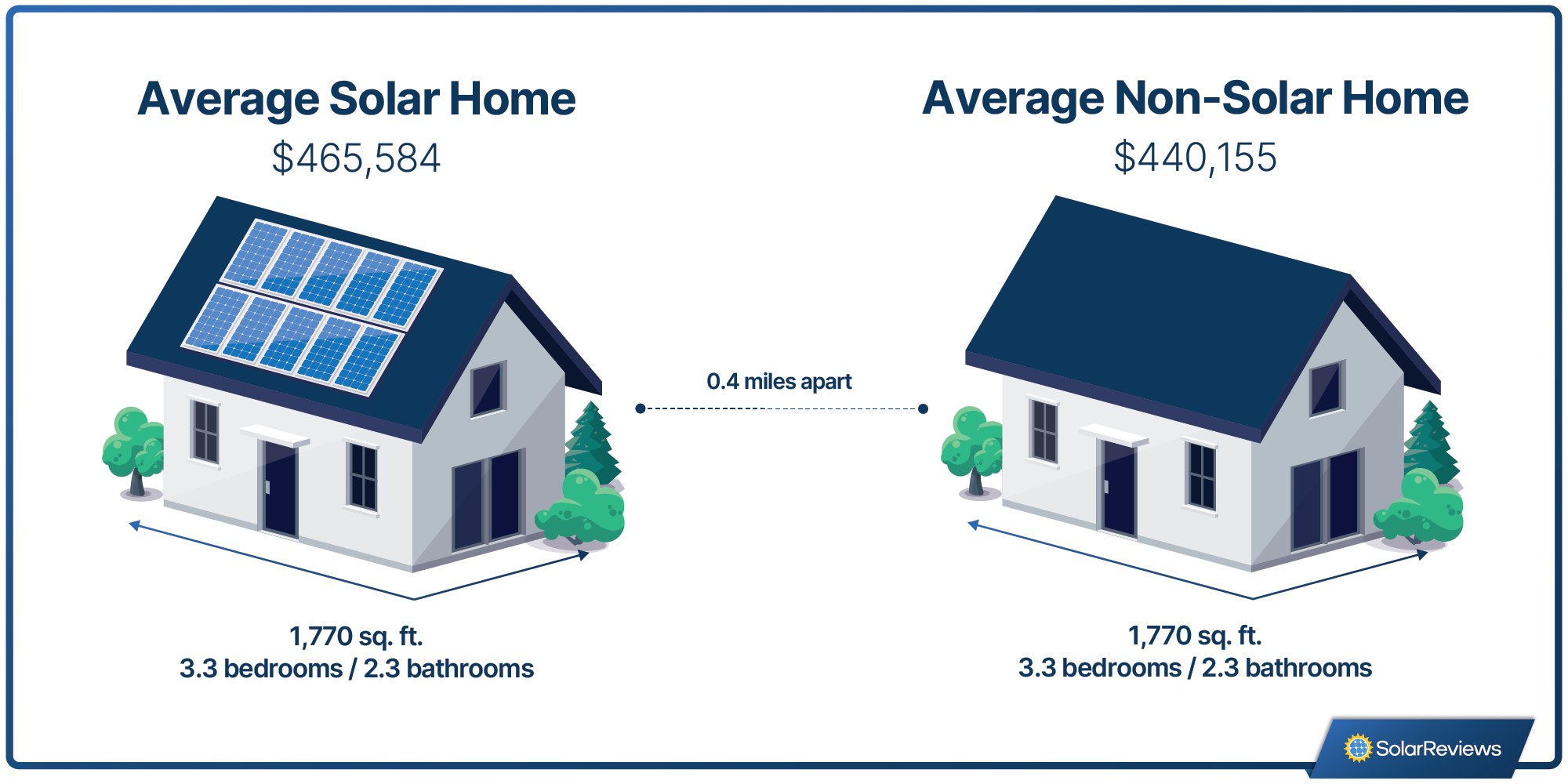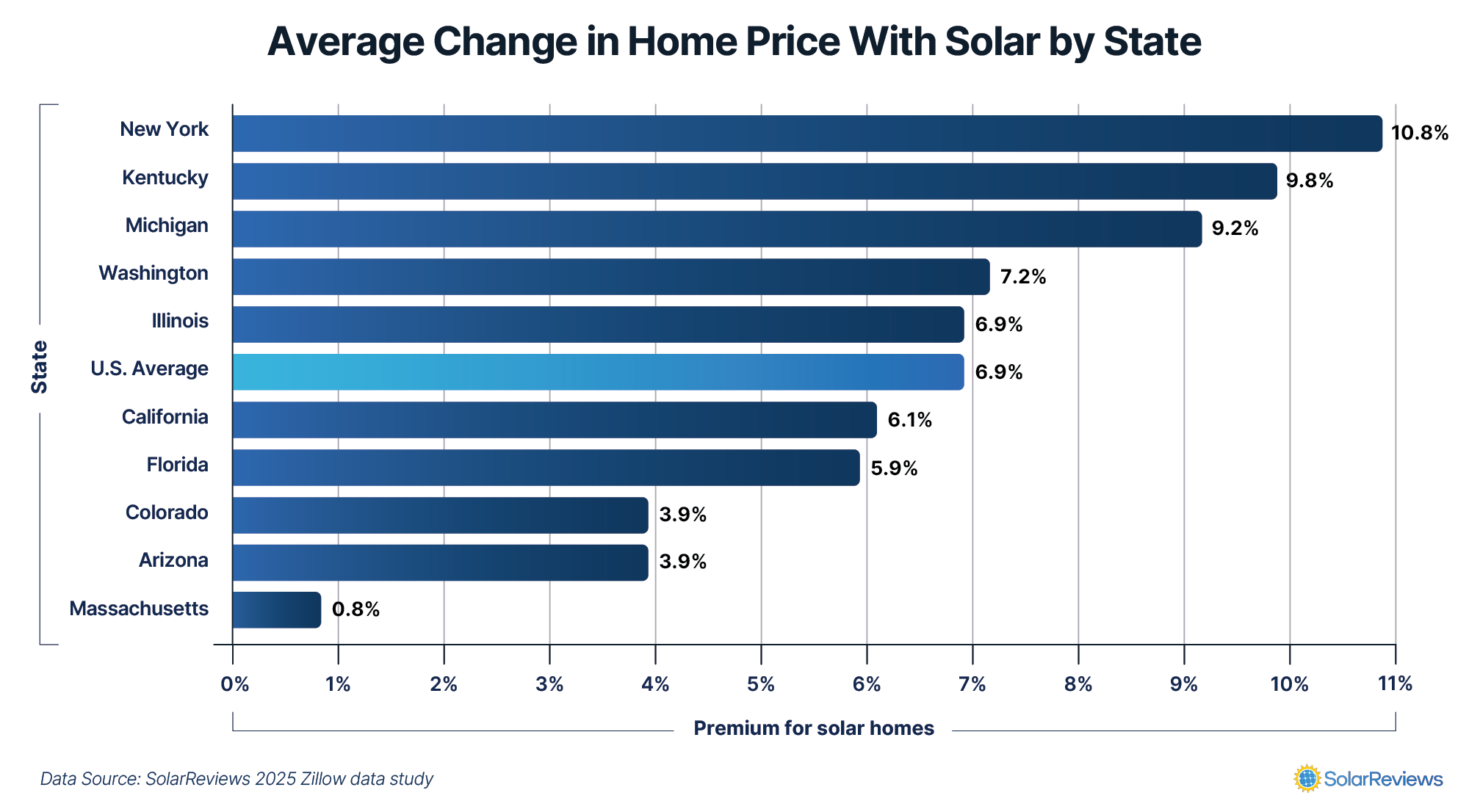Updated 2 months ago
Homes with Solar Sell for 6.9% More [2025 Zillow Data Study]
Written by
Ana Almerini
In 2019, Zillow published a groundbreaking statistic that homes with solar panels sold for about 4.1% more than homes without solar installed.1 However, since 2019, home solar installations have more than doubled in capacity.2 With more solar homes on the market than ever before, how do home buyers currently value homes with solar arrays?
We compared over 400 homes to better understand how solar panels affect home value.
We focused on these specific insights:
Homes sold with solar panels vs homes sold without solar panels
Only homes sold in the last 3 years
Median home values
Home location, including city and state
This study breaks down what our research uncovered.
Key Findings
On average, across the United States, homes with solar sell for 6.9% more than homes without solar.
The sale price increases by about $25,000 for a home with solar.
Four out of the 36 states in our study saw an increase of less than 2% on homes with solar. In one state (Alabama), non-solar homes sold for about 5% more than comparable solar homes.
Methodology: How We Calculated This Figure
To ensure this study was as detailed — and unbiased — as possible, the SolarReviews team spent more than a month replicating Zillow’s data study. We assessed over 400 recently sold home listings on Zillow, comparing homes with and without solar.
For every solar home, we found a non-solar home that was located in the same area, had similar square footage, and was sold around the same time, and we compared sale prices. Specifically, to be included in our dataset, comparable solar and non-solar homes had to fit the following criteria:
Timeframe: Homes sold within 180 days of each other
Size: Homes sized within 200 square feet of each other
Location: Homes in the same neighborhood (less than ~0.5 miles apart)
Accommodations: Homes with the same number of bedrooms and bathrooms (a difference of up to 1 bedroom OR 1 bathroom was allowed if the square footage was comparable)
Appearance: Homes with similar curb appeal
Layout: Homes with same number of levels and similar amenities, such as pools
Age: Homes built in the same time period
Here is the average difference between solar homes and non-solar homes in our dataset:
Number of days between sales: 67.1 days
Distance between homes: 0.4 miles
Difference in square footage: 67.8 square feet
Number of beds/baths in solar homes: 3.3 beds / 2.3 baths
Number of beds/baths in non-solar homes: 3.3 beds / 2.3 baths
On average, the solar homes in our dataset were built 3.2 years after their non-solar counterparts.

What Was Not Included in the Dataset
States where we could not find recently sold homes with solar panels, i.e., North and South Dakota.
Homes in “non-disclosure states,” where information about selling price and date of sale are not publicly available.3
One-bedroom, one-bathroom homes.
Zillow Data and Home Value Report
By comparing over 400 homes with and without solar that have sold in the last three years, we found that homes with solar panels now sell for 6.9% more than their comparable non-solar counterparts. That translates to an additional almost $29,000 for a median-valued home.4 (For context, the average cost to install solar panels is $19,000, so that’s about a $10,000 instant ROI).
The housing market has not been consistent since 2020. We’ve seen increased demand in typically slower markets, interest rates fluctuating from all-time lows in 2020-2021 to spikes in 2022-2023, and inflated housing costs as demand dwindles.5 Whether it was a buyer or seller's market, over the three years we studied, solar panels consistently added value to homes across the country.
State Trends
While the average U.S. home with solar sold for 6.9% more than a comparable non-solar home, the data varied between states. Of the states in our study, 44% saw higher margins than the U.S. average, while 66% saw lower margins. Here are a few examples of states with higher and lower added value:

Major City Trends
We looked at homes in 62 distinct cities. Here is how the selling price compares between solar and non-solar homes in a few major metro areas:

Statistics vs. Realtors’ Experiences: Does the Data Line Up?
The National Association of Realtors (NAR) conducts an annual Realtors & Sustainability Report that determines realtors’ general sentiment around home buyers’ perceptions of sustainability, like whether having solar panels or proximity to public transportation is important when looking for a home.6
In the 2024 report, 31% of agents said they perceived solar to increase home values in their markets.
Brett Johnson, owner of New Era Home Buyers, agrees.
“I have noticed a trend where the presence of solar panels can greatly impact the sale of a home,” Johnson says. “Properties that come equipped with solar panels often catch the eye of buyers and tend to sell more quickly. The appeal stems not just from the energy savings over time, but also from the increasing preference for eco-friendly living among today’s home buyers.”
Don Wede from Heartland Buys Houses notes: “Houses with solar panels are valued favorably in the real estate market. The characteristics of being modern, environmentally friendly, and cheap can appeal to a buyer better.”
Along with having the potential to increase property value, in some cases, solar can help homes sell more quickly. In the NAR survey, 57% of realtors said promoting a home’s energy efficiency in a listing was very or somewhat valuable.
“Many homebuyers are actively looking for homes that already have solar panels installed,” Johnson says. “I have encountered clients who express [a specific] interest in properties with these sustainable features and acknowledge both their immediate and long-term advantages.”
As sustainable options become more of a priority for home searchers, adding solar panels can add an extra layer of value to a home in the eyes of prospective buyers.
Ana is the Marketing & Communications Manager at SolarReviews, working within the solar industry since 2020. With a Master's in Climate and Society and professional experience in marketing, she helps communicate the value of solar to homeowners and build awareness of the SolarReviews brand. On weekends you can find her at the Jersey shore, reading a book from the ever-increasing stack on her side table, or eating food someone else cooked....
Learn more about Ana Almerini